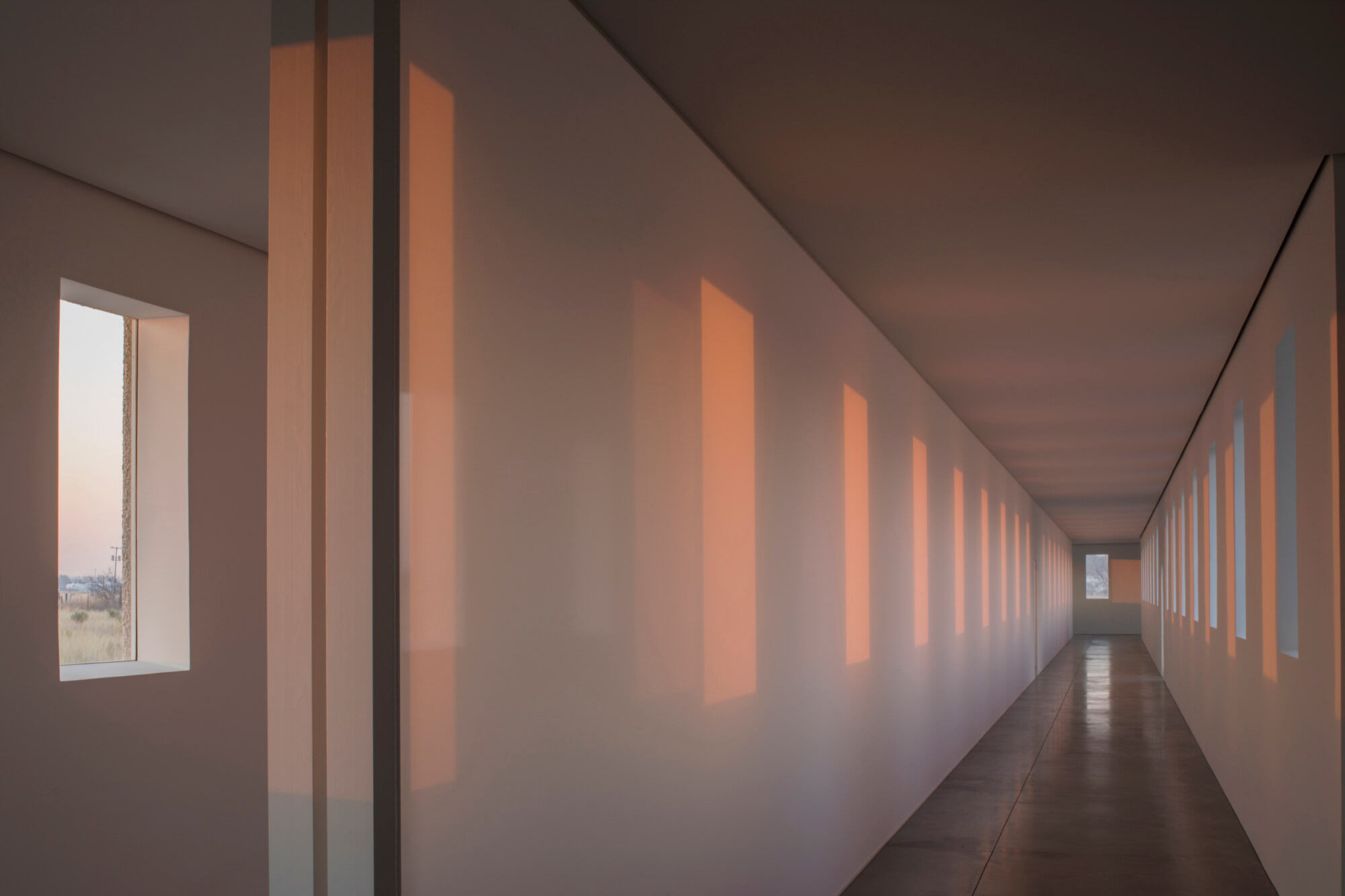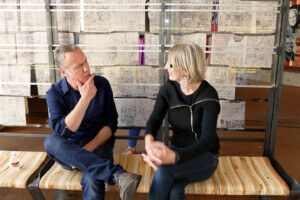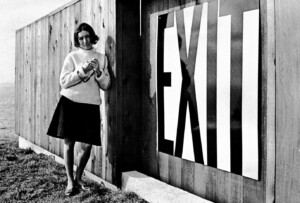The American artist Robert Irwin died last month at age 95. Irwin was a towering presence in the art world, but his work and thinking was influential among architects as well. After serving in the military and becoming a painter who covered his expenses through swing dancing and betting on horses, he set aside 2D canvases by 1970 to explore space itself. Across the following half century, Irwin authored many captivating temporary pieces, like Scrim veil—Black rectangle—Natural light, Whitney Museum of American Art, New York (1977), which ran a plane of scrim across the open top floor of Breuer’s building for the Whitney, engaging its cyclopean window. (Perhaps Sotheby’s might be game for a rerun?) His concern was our perception of phenomena; he made us see that light isn’t something that just illuminates other objects; it can be made visible, felt, experienced.
Irwin completed permanent outdoor works for the University of California San Diego and the City of Dallas, among others, in addition to more ambitious proposals, like the entry sequence for Miami Airport, which went unbuilt. Beyond his work on rehabilitating a Nabisco factory into Dia:Beacon, perhaps his crowning landscape achievement was the garden at The Getty in Los Angeles, a tour de force of texture, color shape, and sound, realized despite the protestations of the campus’s architect, Richard Meier.
I heard Irwin’s voice in my ear exactly once, when I picked up the phone while stationed at the front desk at the Chinati Foundation as an intern. “It’s Bob,” he said, with no pretense. At the time, conceptual work was already underway for what was to become Untitled (dawn to dusk) (2016), a permanent installation which reconstructed an old army hospital into a device for inhabiting the light of Far West Texas. The construction of this work is featured prominently in A Desert of Pure Feeling, a documentary about Irwin which is now streaming.

Below, AN shares a tribute to Irwin from his friend Lawrence Weschler, who first wrote about the artist’s work in his 1980 book Seeing is Forgetting the Name of the Thing One Sees. Weschler originally published this text on his Substack, Wondercabinet. —Jack Murphy

Robert Irwin (1928-2023) RIP
As many of you will have by now heard, the artist Robert Irwin, my dear longtime friend (coming on almost fifty years now) and in many ways my originary subject (the principal, for starters, of my very first book, Seeing is Forgetting the Name of the Thing One Sees, from back in 1980, with a second edition in 2007) died peacefully last Wednesday, at age 95, his wife Adele at his side, following a short illness. I’d visited with him myself the week before at his hospital bedside in La Jolla, where he drifted in and out of copresence, though at moments he grew piercingly, almost achingly himself.
As it happens, I received word of the death itself as, back home in New York, I was heading out to JFK for a red-eye flight to London, where I was slated to take part the next day in the long-planned European premiere of the new documentary film on his life and thought, A Desert of Pure Feeling, which has likewise recently begun screening around the US. I’ve regularly continued writing about Irwin’s progress throughout those fifty years (and he was indeed progressing right to the very end—see my New York Times piece on a penultimate show of his at Pace back in 2020 here, and for that matter my coverage of his subsequent 2022 Pace show back in Issue 14 of this very Substack), and I expect to be writing a good deal more about Bob in the months to come as I prepare a final third edition of the book. On the flight out to London, though, I found myself dipping back into Seeing for the first time in a long while, and found many of the pages piercingly achingly pertinent to the moment at hand. And so by way of send-off here I thought I’d just invite you into the last few pages of the second edition, picking up with Bob and me engrossed in yet another of our at-that-time over thirty years’ worth of tumbling, meandering conversations, that time in the work studio of his San Diego home:
Irwin was quiet for a minute, thinking back, casting forward: his dear friend Ed Wortz, his old NASA buddy from the Art and Technology days of the late sixties, who’d remained one of his closest interlocutors all the years since, had died just a few months earlier following a long slow illness.
“I watched Ed through the whole process of his dying,” Bob resumed. “He had this incurable cancer which he held in abeyance pretty much solely based on his curiosity. He really got into it. He researched it and got into the whole process, volunteering for these radical therapies. The doctors that he was working with, they loved him because he was the best feedback candidate they ever could have had. He really observed everything that was going on, and reported on it. But he would get weak in the afternoon and he’d have to go in and lie down on the bed. And a number of times I’d lie down there with him. We’d actually hold hands, and he would talk about this whole process of dying. He was observing it the same way he had observed everything else, as a scientist, you know, really thinking about what it was like—what kind of emotions and feelings—and so he gave me a whole exercise in dying, in a way.”
What had they talked about?
“Well, fairly similar to what we’re talking about here, and what he and I were always talking about. It was not a fear of anything. It was not about absence. He was dealing with presence. He was all about what kind of feelings were going on right then, what kind of emotions, what kind of…. But he really did enjoy himself. He enjoyed his life right up almost to the end. (It got a little rough there at the very end.) He was talking about the way that you don’t let go of what it is that’s always been interesting and important to you, that the dying doesn’t change that. That dying’s just another in a series of activities or experiences. It’s going to happen, it happens to everybody, it’s not a thing to run from.”
But what about raging, raging against the dying of the light? I continued to marvel at this uncanny equanimity of Bob’s and Ed’s. Maybe, I wondered out loud (another instance of the sort of thought-skipping we used to indulge in back in the days, under that tree at UCLA’s North Campus Library), if you think about the way death is always conceived of as a blacking out—this dying, as it were, of the light—and what with Irwin’s work so steeped in light (he, after all, being the quintessential Light and Space artist), and, yes, with California light in particular, maybe there was a burrowing connection between that light and the light of the Enlightenment, and, more specifically, that tiny light which Descartes finally uncovered deep within himself at the tail-end of his own long night of radical doubt, the light of reason, which light for him…
“Reason,” Bob interrupted, “precisely, which is the one thing {as opposed to the logical operations that a computer, say, might evince} that most clearly defines our potential as human beings. I mean, reason is even above love. It’s above all those things. They’re all nice and all, but what really makes human beings special, really special, is that ability to reason.”
That light of reason, as I was saying, deep within himself, which for Descartes was but a deep-implanted reflection of the greater light, which was the Light of God.
“Which of course is ridiculous. What did he, what does anyone need God for? Let alone know of Him. That’s just an evasion.”
(Still, one could think about the way the light of reason and the light of the world reflect one another, summoning each other forth.)
“God is just an evasion.” Bob wouldn’t give it up (he seldom passes up an occasion to take another blissful whack at God). “An evasion of responsibility. Even if there is a God: Fine. So what? That wouldn’t replace your responsibility to act on your own unique potential. When I talk about reasoning, it’s something only an individual can do because it’s all about this idea of taking individual responsibility, it means reasoning your own being in the here and now. And that’s the most spectacular thing that human beings can do. It’s the epitome—the highest level of attainment.”
So: no god, no prospect of an afterlife… But seriously, what about the fate of an art whose very essence has been presence, the artist’s own being present-to, in the face of the inevitable fact of his coming absence?
“Oh,” he said, “I don’t worry about that. Why should I? I won’t be here. And as far as the dialogue that my own striving after presence has been part of, that dialogue will go on, assuming the world goes on. Which, of course, what with global warming and all, is a matter of increasing concern.”
And what about that? He’d always shied away from political engagement, considering political art, as such, more politics than art, or at any rate a third or fourth order of art rather than the primary sort he himself was interested in pursuing. But in a world facing the sort of urgent immediate challenges subsumed under that global warming rubric, was there a problem perhaps with such a steadfast pursuit of pure, unsullied primary art?
“On the contrary,” Bob now insisted. “Viewed the right way, that piece right now back there at Pace, the DIA in Beacon, the gardens up at the Getty are all about global warming. How can one not be aware of and concerned about all that? But it comes back to this question of human beings taking responsibility. I keep using this word responsibility, this setting in motion your own meaning. { . . . } At the root of it all, there’s individual meaning, the source of an individual’s taking on of his or her own free action, based on his or her own embeddedness, which is to say, awareness of the world, in all its dazzling complexity and immediacy and interconnectedness. In a civilization where people had been sensitized to act on that level, to be present in that way, things like global warming would be addressed immediately, they would have to be.”
I mentioned how I’d been talking to a scientist the other day who suggested that in the immediate future mankind might well be facing a choice between utopia and extinction.
“Yeah,” Bob concurred. “I think that’s true. It really is.”
The afternoon was winding down, the lightwell facing Irwin’s drafting table was filling up with dim.
I reminded him how he often talked about not expecting to live to see the realization of the sort of world his own art was aspiring to, that such a realization could indeed still be generations off. What, I now asked him, did he have in mind? Was it (I was suddenly in a tweaking mood, wanting to dispel the mood of somber sobriety that had strangely overtaken us) a question, for instance, of there not yet being sufficient computer power, such that artists in the future, properly endowed with the requisite terabytes, might be able to infuse visors with ecstasies of virtuality barely even dreamed of…?
“Of course not!” Bob erupted. (I’d managed to provoke exactly the rise I was hoping for.) “The point is to get people to peel off their visors, to remove the goggles, to abandon the screens. Those screens whose very purpose is to screen the actual world out. Who cares about virtuality when there’s all this reality—this incredible, inexhaustible, insatiable, astonishing reality—present all around!”
In the event, I launched my comments at the premiere screening of the documentary at the London ICA with a perhaps even more hauntingly apt passage from the far other side of the book, indeed its very first paragraph from before the table of contents:
During the early sixties, when Robert Irwin was on the road a lot, visiting art schools and chatting with students, he was proffered an honorary doctorate by the San Francisco Art Institute. The school’s graduation ceremony that year took place in an outdoor courtyard on a sunny, breezy afternoon, sparkling clear. Irwin approached the podium and began, “I wasn’t going to accept this degree except it occurred to me that unless I did I wasn’t going to be able to say that. He paused, waiting as the mild laughter eddied. “All I want to say,” he continued, “is that the wonder is still there.” Whereupon he simply walked away.
And indeed, now, it is as if Bob has simply walked away. Except it isn’t like that at all. For if Bob taught us anything it was that presence, true presence, was never about absolute present-tense immediacy. Rather it was about duration, the experience of the fullness of time in its passing, and Bob’s presence for me and I suspect many others will be enduring and indeed everlasting.
Lawrence Weschler, a graduate of Cowell College of the University of California at Santa Cruz (1974), was for over twenty years (1981–2002) a staff writer at The New Yorker, where his work shuttled between political tragedies and cultural comedies. He is at work on a final third edition of Seeing is Forgetting the Name of the Thing One Sees.











